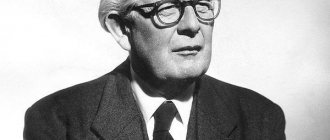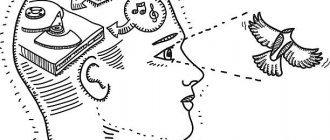Festinger's theory
The phrase, which we often use when there is a discrepancy between expectations and reality, was introduced into use by the American psychologist and specialist in the field of psychology of thought regulation Leon Festinger.
A widely known study is in which he and his students observed the behavior of people belonging to the Guardians of the Cosmos sect. Adherents were sure that the end of the world was about to come. For this, they abandoned their family, work, housing and began to wait for Judgment Day and salvation from aliens.
When the appointed day arrived without any consequences, the believers cleverly found an explanation for this. Their prayers extended the existence of the world!
Analyzing such stories, Festinger concluded that for the sake of peace, the brain seeks to explain what is happening by hook or by crook. He called the discomfort and tension that arises in a state of uncertainty cognitive dissonance.
Objectivity of experiments conducted by the authors of the theory
There are also individual differences in whether people act as the theory predicts. Highly anxious people are more likely to do this. Many people seem to be able to cope with significant incongruity and do not behave predictably.
Finally, many studies supporting cognitive dissonance theory have low validity. For example, turning pegs (as in Festinger's experiment) is an artificial task that does not occur in everyday life. Additionally, most experiments used students as participants, which raise issues of sample bias. Can we generalize the results of such experiments?
What does cognitive dissonance mean?
The phenomenon of cognitive dissonance was described in 1957 by the American psychologist L. Festinger. He noted that people strive for inner harmony and balance between the information they receive and their own motives, ideas and experiences from the past.
The state of mental or psychological discomfort that occurs when this balance is disturbed is called cognitive dissonance. It can also be caused by logical contradictions, contradictions between thoughts, knowledge, beliefs, attitudes, actions, feelings or emotions.
According to balance theory, people strive for harmony, consistency, and coherence in their knowledge system about the world. It is difficult for the psyche to be in a state of alarming inconsistency that causes unpleasant sensations.
Therefore, consciousness strives to smooth out the emerging contradiction.
A classic example is a smoker learning about the negative consequences of smoking. This causes cognitive dissonance: pleasure/harm. Human can:
- quit smoking (“I want to maintain my health”);
- convince yourself that you don’t smoke much (“it can’t have a big impact on your health”);
- justify your habit, taking into account new facts (“I will smoke less / replace cigarettes with less harmful ones”);
- find the positive aspects of smoking (“while I smoke, I don’t gain weight”);
- look for data that refute the harm of smoking (“the information is exaggerated, there are people who smoke all their lives and feel good”).
Essentially, people tend to block unfavorable information, devalue its negative aspects, find the necessary evidence, justify their choices and reassure themselves.
This is how a protective mechanism works, which allows you to maintain mental health under stress, as well as an adaptation mechanism that helps you adapt to an uncomfortable life situation.
Causes
Cognitive dissonance is a state when a collision of contradictory knowledge, behavioral attitudes, and beliefs regarding some phenomenon or object occurs in a person’s mind. This is the discomfort caused by the contradiction between already established ideas and new incoming facts that cause “inconsistency.”
This condition can occur for several reasons:
- because of a logical contradiction, like “I don’t care what others think, but I want to become famous”
- due to inconsistency of a person's decisions and behavior with the cultural customs of his country, social group or family
- when new information contradicts the previous picture of the world
2 consequences after CD:
- A person strives to establish correspondence (consonance) with reality.
- In the future, he will avoid situations that caused this condition.
How can you reconcile your inner feelings and beliefs with your behavior?
- Justify yourself. For example, telling a pregnant woman that she is a traitor (since she got pregnant from you so unexpectedly) or is somehow different, thereby justifying your cowardly escape from her.
- Avoid situations that cause dissonance. I promised myself not to eat after 18:00 - please stick to this rule. I promised myself.
- Act by changing your behavior pattern or attitude towards the situation or phenomenon that has arisen.
Conducted research and experiments
All research can be divided into three main areas:
1. Enforcement behavior.
2. Decision making.
3. Application of effort.
We will review the main findings that have emerged in each area.
Example of Enforced Compliance Behavior
When someone is forced to do (publicly) something they (privately) really don't want to do, there is a dissonance between their cognition (I didn't want to do that) and their behavior (I did that).
Coercive compliance occurs when a person does something that does not align with his or her beliefs. Behavior cannot be changed since it has already been used, so it is necessary to reduce the contradiction by reconsidering the attitude towards your actions. This prediction was tested experimentally in the cognitive dissonance “Peg Turns” experiment.
Example 1
In an intriguing test taken in 1959, scientists Festinger and Carlsmith asked participants to complete a series of tasks. One of them was to turn the pegs on the board for an hour. As you can imagine, the participants' attitudes towards this task were extremely negative.
| Target | Festinger and Carlsmith in 1959 tested whether creating humans to complete a task would create cognitive dissonance through enforcement behavior. |
| Method | In their laboratory experiment, they tested 71 male students as participants to perform a series of tasks (such as spinning pegs on a board for an hour). They were then paid either $1 or $20 so that he could tell the waiting participant that the problems were actually interesting. Almost all participants agreed to go to the waiting room and announced that the experiment would be exciting. |
| results | When asked to rate the experiment, participants who were paid just $1 rated the tedious task as more fun and enjoyable than participants who were paid $20 to lie. |
| Conclusion | Paying just $1 is an incentive to lie, so dissonance arises among those who were paid $1. It could only be overcome by believing that the tasks were truly interesting and enjoyable. $20 provides a reason to turn the pegs, so there is no dissonance. |
Decision Making Example
Life is full of decisions, and decisions usually cause disharmony. Let's say you had to decide whether or not to take a job on the other side of the country and be close to your friends and family. Either way, you will experience dissonance. If you accepted the job, you would miss your loved ones. If they refused the job, they would regret the lost opportunity.
Both alternatives have their pros and cons. The problem is that the decision eliminates the possibility that you can enjoy the benefits of the unselected alternative. At the same time, it assures you that you must accept the shortcomings of the chosen alternative.
People have several ways to reduce the discrepancy that results from a decision. One thing they can do is change behavior. As noted earlier, this can be very difficult, so people use various mental maneuvers. A common way to reduce dissonance is to increase the attractiveness of the chosen alternative and decrease the attractiveness of the rejected alternative. This is called “expanding alternatives.”
Example 2
Brehm in 1956 was the first to study the relationship between disharmony and decision making.
| Target | Studying the decision-making stage |
| Method | Participants were told that they would be assisting in a multi-industry funded study. Participants were also eligible to receive one of the products at the end of the experiment to compensate for their time and effort. The women then rated the desirability of eight household products that ranged in price from $15 to $30. Products included an automatic coffee maker, an electric sandwich grill, an automatic toaster, and a portable radio. Participants in the control group were simply given one of the foods. Because these participants had not made a decision, they had no dissonance to reduce. |
| results | People in the low dissonance group chose between a desired product and a rating 3 points lower on an 8-point scale. Participants in the high dissonance condition chose between a highly desirable product and one rated 1 point lower on an 8-point scale. After reading the reports of various products, people have rated the products again. |
| conclusions | Participants in the high dissonance condition were more dissonant in addition to alternatives than participants in the other two conditions. In other words, they were more likely than participants in the other conditions to increase the attractiveness of the alternative and decrease the attractiveness of the unchosen alternative. |
Effort Example
We value more goals that required significant effort to achieve. This is probably because dissonance would arise if we put a lot of effort into achieving something and then evaluate it negatively. Of course, we could spend years of effort trying to achieve something that would be nonsense. And then, to avoid the dissonance that arises, try to assume that we really haven't spent years of effort, or that the effort has been really very enjoyable, or that it hasn't been very much effort.
In fact, it is easier for us to convince ourselves that a hard-won result is more valuable than one achieved with less effort. This method of reducing dissonance is known as justification of effort.
If we put effort into a task and it ends in failure, we experience dissonance. To reduce this dissonance, we are motivated to think that the task was a success.
Example 3
Research by Aronson and Mills in 1959 demonstrates the basic idea.
| Target | Identify the relationship between dissonance and effort. |
| Method | The students volunteered to take part in a discussion on the psychology of sex. In a "mildly embarrassed" condition, participants read a list of gender-related words such as "virgin" and "prostitute" to a male audience. In a state of "serious embarrassment" they had to read out loud obscene words and a very explicit sexual passage. In the control condition, they went straight into the main study. Then, in all conditions, they heard a discussion about sex in lower animals. They were asked to rate how interesting they found the discussion and how interesting they found the people involved in it. |
| results | Participants in the “severe embarrassment” condition gave the most positive ratings. |
| Conclusion | If you have experience that is costly, the dissonance is reduced. This helps justify the effort. |
Examples of cognitive dissonance
Parents talk obscenely or smoke, or say nasty things about people behind their backs, or throw things around the house. And the child is punished for the same thing, because... this is very bad".
Dissonance: the main people in his life do this, but only very bad people do this.
Means:
- Or it is actually possible and necessary to do this. Only when you are in charge. So as not to be scolded. And it is also advisable to give this advice to those who are weaker. And to your future children, to pass on, so to speak, knowledge.
- Either it is undignified to do this, and it turns out that the parents do bad things. This means that something is pushing these best people in the world towards this, and this must be eliminated. For example, to earn money for them or to protect them from the influence of bad people. And then a goal appeared, replacing the child’s own desires and inclinations. A goal from which he can only wake up a little later at an appointment with a psychologist during a period of existential crisis.
- Or the parents are bad people. But for such a choice, parents need to try very hard. Long and consistent.
Unpleasant, but inevitable. Children, on average, have fewer opportunities than adults to see a third alternative or change their present. Therefore, it is so important to remember that children are a direct or inverse mirror of our actions.
Good news: How a crisis leads to change, incl. positive to a certain extent, so the discomfort of cognitive dissonance provokes the evolution of our knowledge, thoughts and actions.
The best thing we can do for ourselves in such a situation is to look for more information, expanding our field of choices. And make the choice consciously. As the author of your life.
A few more examples:
- A guy in a wheelchair sits near a store and asks for money. You give it to him and on the second day you see him walking down the street normally. And you begin to experience cognitive dissonance.
- The parents told the 6-year-old girl that she should not drink alcohol under any circumstances. And one day she sees her father coming home drunk.
- A girl from an intelligent family married a guy who had served time, whom her family did not like. And in order to justify him, she stole some thing from the store. To prove everyone wrong and get out of a state of discomfort.
- The father always insisted to his son that they should give up their seats on the bus to the elderly, but he himself did not budge when an old woman of about 80 stood next to him.
Cognitive dissonance and marketing
The human brain cannot exist between two theories: in dissonance between reality and its expectations or ideas about something. He needs to make a choice. And most often people choose what is easier. Instead of healthy criticism and acceptance that he made the wrong choice and needs to look for solutions, a person engages in self-deception by refusing responsibility for what happened.
Cognitive dissonance happens when your words/thoughts/actions contradict your beliefs.
The marketer’s task is to reduce cognitive dissonance or use its pressure. For example, messages such as “Most users consider this product too expensive, so the circle of our customers is very narrow.” I mean, I understand that it's overpriced, but it's cool to be among the "special ones."
In marketing, the Foot-in-the-Door technique is often used - gradually complicating the task for the user. “First, I’ll sign up for the free newsletter. I will buy an inexpensive product at a discount that is only available to me. Then I’ll buy something again” – a loyal customer.
Product lines - “oh, well, it’s expensive to buy one, and why do I need it” - “it’s cheaper in a set, what a savings, I’ll take it.”
Examples:
- Buy our product because you deserve it.
- Loving parents buy chocolate/water/toys/sour cream from our brand for their children.
- Real leaders have already subscribed to our channel/read the new book.
- Good housewives use our floor/stove/glass cleaner.
Conclusions from the research conducted
There has been a large amount of research done on cognitive imbalances, with some interesting and sometimes surprising results. This theory shows that we strive for consistency between beliefs and behavior and cannot use very rational methods to achieve it.
However, there is a problem from a scientific point of view because we cannot physically sense cognitive dissonance, and therefore cannot objectively measure it. It turns out that the term “cognitive dissonance” is quite subjective.
There is also some ambiguity (i.e. uncertainty) regarding the term "dissonance" itself. Is it a perception (as "cognitive" suggests), or a feeling, or a feeling about perception? Aronson's reexamination of the idea of dissonance as a discrepancy between a person's self-esteem and knowledge of his behavior suggests that dissonance is nothing more than a feeling of guilt.
Emotional dissonance
Changes in social well-being are caused not by cognitive but by “emotional dissonance.” He is the mechanism of its expression.
Reducing emotional dissonance is a person’s defensive reaction to a bad (depressive) state. By reducing dissonance, they:
- begin to more soberly assess the conditions of their existence,
- strive to be more critical and meaningful about their actions, actions,
- trying to improve themselves or change current circumstances, thereby preparing the conditions for improving their well-being, and then their entire life and work.
All this once again suggests that social well-being is an important condition for any control and self-control over the development system of society and the people in it.
Expert: What is cognitive dissonance?
Aina Gromova – Psychiatrist, psychotherapist, sexologist. Master's in Psychology. Certified specialist OXFORD COGNITIVE THERAPY CENTER (training 2011-2015) Certified family consultant. She has been training psychiatrists/psychologists in family counseling since 2008.
In the video, Aina explains what cognitive dissonance is in simple words.







